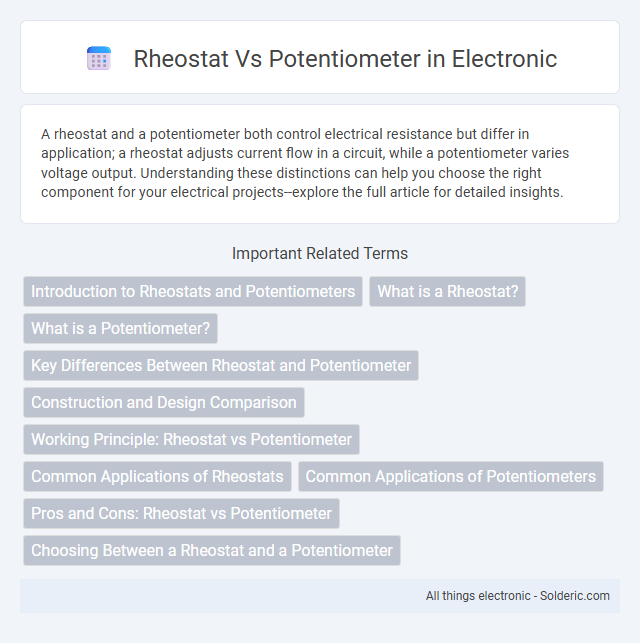A rheostat and a potentiometer both control electrical resistance but differ in application; a rheostat adjusts current flow in a circuit, while a potentiometer varies voltage output. Understanding these distinctions can help you choose the right component for your electrical projects--explore the full article for detailed insights.
Comparison Table
| Feature | Rheostat | Potentiometer |
|---|---|---|
| Function | Variable resistor used to control current | Variable resistor used to divide voltage |
| Terminals | 2 terminals (one end and wiper) | 3 terminals (two ends and wiper) |
| Application | Adjust current, dim lights, control motor speed | Voltage divider in circuits, volume control, sensor adjustment |
| Power Rating | Typically higher power rating | Usually lower power rating |
| Connection Mode | Connected in series | Connected as voltage divider |
| Adjustment | Changes resistance to vary current flow | Adjusts output voltage by sliding contact position |
| Common Usage | Industrial motor controls, lighting | Audio equipment, measurement devices |
Introduction to Rheostats and Potentiometers
Rheostats and potentiometers are variable resistors used to control electrical current, with rheostats typically designed for high power applications by adjusting current flow through a circuit. Potentiometers function primarily as voltage dividers, providing adjustable voltage output by varying resistance across three terminals, commonly used in control interfaces. Both components share similar construction but differ in application and wiring configurations, making them essential in electronics for precise resistance control and signal modulation.
What is a Rheostat?
A rheostat is an electrical device used to control current by adjusting resistance within a circuit, commonly utilized for dimming lights or regulating motor speed. It consists of a resistive wire wound around an insulating core, with a sliding contact that changes the resistance value by varying the length of the wire engaged. Unlike a potentiometer, which controls voltage across three terminals, a rheostat typically operates with two terminals and is specifically designed for higher current applications to manage your electrical flow efficiently.
What is a Potentiometer?
A potentiometer is a three-terminal variable resistor commonly used to adjust voltage levels in electronic circuits by sliding a wiper along a resistive element. Unlike a rheostat, which typically has two terminals and controls current flow, a potentiometer provides precise voltage division, making it ideal for tuning audio, lighting, and other adjustable controls. You can rely on a potentiometer for accurate and smooth control in applications such as volume knobs, position sensors, and calibration devices.
Key Differences Between Rheostat and Potentiometer
Rheostats and potentiometers both regulate electrical resistance, but rheostats primarily control current by adjusting resistance in a single winding, while potentiometers vary voltage by dividing resistance across three terminals. Rheostats typically handle higher power and are used in applications like motor speed control, whereas potentiometers function as adjustable voltage dividers in circuits such as volume controls. Your choice depends on whether you need to control current or voltage precisely in your electronic design.
Construction and Design Comparison
A rheostat typically consists of a resistive wire coil wound on an insulating core with a sliding contact or wiper that adjusts resistance by changing the length of the coil in the circuit. In contrast, a potentiometer features a three-terminal design with a resistive element, usually a carbon or cermet track, and a movable wiper that divides the voltage across the element, enabling it to function as a voltage divider. While the rheostat primarily handles high current loads with a robust coil construction, the potentiometer is engineered for precise voltage control with a compact, flat resistive element.
Working Principle: Rheostat vs Potentiometer
A rheostat controls current by varying resistance in a two-terminal circuit, adjusting the flow of electrical current through a single path. A potentiometer operates as a three-terminal device, allowing you to vary voltage by sliding a contact along a resistive element, providing adjustable voltage output. Both rely on the movement of a wiper to change resistance, but the potentiometer offers precise voltage control while the rheostat primarily regulates current.
Common Applications of Rheostats
Rheostats are commonly used in applications requiring adjustable resistance to control current flow, such as dimming lights, adjusting motor speeds, and tuning the sensitivity of sensors. Their robust design allows them to handle high power loads, making them ideal for industrial machinery and heating elements. Unlike potentiometers, rheostats are typically wired in series and designed to manage higher current, making them suitable for heavy-duty electrical circuits.
Common Applications of Potentiometers
Potentiometers are widely used in electronic devices for adjusting voltage levels, such as volume controls in audio equipment and tuning circuits in radios. They serve as variable voltage dividers, making them essential in calibrating sensors and controlling signal levels in various industrial and consumer electronics. Your devices benefit from the precision and ease of use that potentiometers provide for fine-tuning electrical parameters.
Pros and Cons: Rheostat vs Potentiometer
Rheostats excel in controlling high current loads with simple construction but tend to be bulky and less precise for fine adjustments. Potentiometers offer precise voltage division suitable for signal-level applications but may not handle high power efficiently and can wear out faster due to wiper contact issues. Choosing between a rheostat and a potentiometer depends on Your need for power handling versus adjustment accuracy in your circuit design.
Choosing Between a Rheostat and a Potentiometer
Choosing between a rheostat and a potentiometer depends on their application needs; rheostats typically adjust current in high-power circuits by varying resistance, whereas potentiometers control voltage as adjustable voltage dividers. Rheostats are preferred for applications requiring continuous current adjustment, such as dimming lights or motor speed control, while potentiometers are commonly used in signal conditioning, volume controls, and position sensing. Considering factors like power rating, precision, and circuit function ensures optimal component selection for effective electrical regulation.
Rheostat vs potentiometer Infographic

 solderic.com
solderic.com